





Insecticides and weed killers can be a gardener's best friend, but must be used with caution in a mature garden. I'm not a big advocate of chemical products, but even home-made solutions such as vinegar or insecticidal soaps can be lethal if used incorrectly.
I'm pretty diligent about my garden housekeeping, but once the season really gets underway, my morning walk reveals that the "weedlings" that escaped my plucking have firmly taken root amongst my lovelies. Dandelions are the worst culprits, since the tap root usually defies coming out in one piece. Most weeds are best pulled, if possible, but when you have one growing in close proximity to your plants, you must consider the dangers of using weed killer sprays. Whether you use simple vinegar solution (which will kill or damage anything it touches) or commercial products, this handy spray-safe tool will prevent over-spray and wind-drift problems.
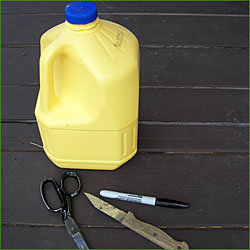
You will need:
A clean plastic milk jug or similar container with cap and handle 2) Cut the circle first. Use the paring knife to start a hole, then finish cutting with scissors. As I stated before, I'm usually diligent about weed-pulling, so I didn't have a dandelion to use for a demonstration. 5) Moving the daylily leaves carefully out of the way, I positioned the spray-guard directly over the oxalis. (A small Columbine plant is also close by.) Make a solution of 20-percent whole eggs and 80-percent water. I purchased processed egg product with yolk (EggBeaters(r) or similar brand). If you wish to use whole fresh eggs, you must remove the white membrane (chalaza) that covers the yolk, which isn't particularly easy. The cartons of egg product have already been strained.
Marking pen
Paring knife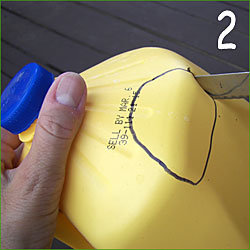
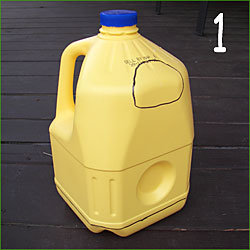
Scissors
1) On the shoulder of the jug, draw a 2-inch circle. Position the circle based on whether you will spray with your right hand or your left.
Now draw a line around the base of the container at a point that will allow it to stand up by itself.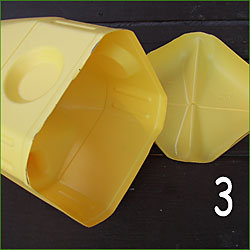
3) Again, use the knife to start a hole, then cut off the bottom.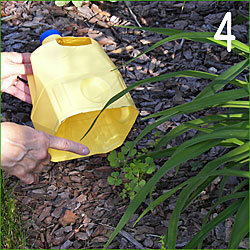 4) I would ordinarily just pull this oxalis that is nestled up against my prize daylilies, but it will work to show the concept of the spray guard.
4) I would ordinarily just pull this oxalis that is nestled up against my prize daylilies, but it will work to show the concept of the spray guard.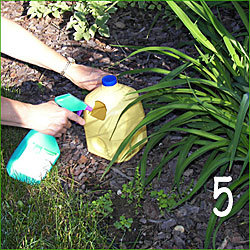
Place the nozzle of the spray well inside the hole and direct the weed killer onto the plant. Use as little as possible--don't drench the weed.
Always check the conditions under which a product is to be used. Some weed killers require 24 hours of dry weather or direct sunlight after application in order to be effective.
The main advantage of the spray-guard is that you can apply the product any time, whether the wind is blowing or not!
For insect control, use the spray-guard the same way, but make your rounds in the early morning or at dusk when beneficial insects are not active (bees, butterflies, etc.). I recently discovered aphids on the new growth of a dwarf weeping crabapple. I slipped the spray-guard over those branch tips and sprayed them with organic insecticidal soap. The next day, all the aphids were dead.
Plain old cider vinegar is one of the best weed killers I know. Used full strength, it's perfect for cracks and crevices.
Insecticidal soaps work with nature by disrupting an insect's cell membranes, thereby killing it by dehydration. This is not a new concept--soap has historically been used as an all-purpose pesticide. It must be diluted with water, or it will also kill nearby vegetation. The important key here is to use SOAP, not detergent. Mix 2 tablespoons of liquid soap into 1 quart of water and use as needed.
Deer Problems? I was thrilled to find this recipe for home-made egg-based deer repellent, courtesy of Colorado State University Extension. It really works! And it lasts up to three months, even with rain. In early April, my emerging hostas and sedum were chewed to the ground. I made this repellent and sprayed what was left of them, plus every other tender plant that was accessible to the local deer population. I haven't re-applied the solution and we've had torrential rains the past two months, so these photos are proof!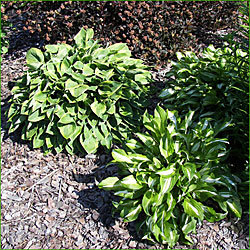
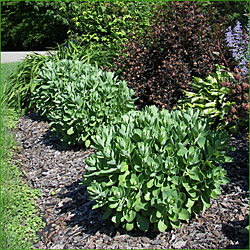
We all can do our part to protect our planet's resources and wildlife, and as gardeners, we have a vested interest in our own little corner of that world.
Copyright © www.100flowers.win Botanic Garden All Rights Reserved